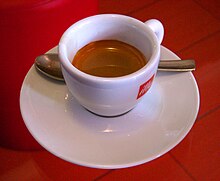
Back Espresso Afrikaans قهوة إسبريسو Arabic Café espreso AST Espresso Azerbaijani Эспрэса Byelorussian Еспресо Bulgarian Espresso BS Cafè exprés Catalan Espresso Czech Espresso Welsh
This article possibly contains original research. (February 2024) |
 A cup of espresso from the comune (municipality) of Ventimiglia, Italy | |
| Country of origin | France or Italy |
|---|---|
| Introduced | 1901 |
| Color | Black or brown |
| Nutritional value per 100 g (3.5 oz) | |
|---|---|
| Energy | 8.4 kJ (2.0 kcal) |
0. | |
0.2 | |
0.1 | |
| Vitamins | Quantity %DV† |
| Riboflavin (B2) | 15% 0.2 mg |
| Niacin (B3) | 33% 5.2 mg |
| Minerals | Quantity %DV† |
| Magnesium | 19% 80 mg |
| Other constituents | Quantity |
| Water | 97.8 g |
| Theobromine | 0 mg |
| Caffeine | 212 mg |
| †Percentages estimated using US recommendations for adults,[1] except for potassium, which is estimated based on expert recommendation from the National Academies.[2] | |
Espresso (/ɛˈsprɛsoʊ/ , Italian: [eˈsprɛsso]) is a concentrated form of coffee produced by forcing hot water under high pressure through finely-ground coffee beans. Originating in Italy, espresso has become one of the most popular coffee-brewing methods worldwide. It is characterized by its small serving size, typically 25-30 ml, and its distinctive layers: a dark body topped with a lighter-colored foam called crema.
The modern espresso machine was developed in the early 20th century, with significant innovations by Italian inventors such as Angelo Moriondo, Luigi Bezzera, and Desiderio Pavoni. These machines use pressure to extract a highly concentrated coffee with a complex flavor profile in a short time, usually 25-30 seconds. The result is a beverage with a higher concentration of suspended and dissolved solids than regular drip coffee, giving espresso its characteristic body and intensity.
Espresso serves as the base for numerous popular coffee drinks, including cappuccino, latte, and americano. It can be made with various types of coffee beans and roast levels, allowing for a wide range of flavors and strengths. The quality of an espresso is influenced by factors such as the grind size, water temperature, pressure, and the barista's skill in tamping the coffee grounds.
While espresso contains more caffeine per unit volume than most coffee beverages, its typical serving size results in less caffeine per serving compared to larger drinks like drip coffee. The cultural significance of espresso extends beyond its consumption, playing a central role in coffee shop culture and the third-wave coffee movement, which emphasizes artisanal production and high-quality beans.
- ^ United States Food and Drug Administration (2024). "Daily Value on the Nutrition and Supplement Facts Labels". FDA. Archived from the original on 27 March 2024. Retrieved 28 March 2024.
- ^ National Academies of Sciences, Engineering, and Medicine; Health and Medicine Division; Food and Nutrition Board; Committee to Review the Dietary Reference Intakes for Sodium and Potassium (2019). Oria, Maria; Harrison, Meghan; Stallings, Virginia A. (eds.). Dietary Reference Intakes for Sodium and Potassium. The National Academies Collection: Reports funded by National Institutes of Health. Washington, DC: National Academies Press (US). ISBN 978-0-309-48834-1. PMID 30844154. Archived from the original on 9 May 2024. Retrieved 21 June 2024.
© MMXXIII Rich X Search. We shall prevail. All rights reserved. Rich X Search